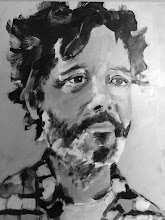
National Portrait gallery, London, 2009.
Macca's 70 soon. All the Old Gods nearly are dead. Icons. Our instant access culture makes it hard for anything to register and have an impact like it used to. We've all seen it, done it, got the T-shirt. No more so than in the world of Rock. I mean, really, do you care about U2 playing Glastonbury, 2010? That's the best we got? Sad.
So, with thoughts like that in my noggin, I paid 11 quid to see this show. Swinging London and those wot won it. The Golden Age. Some slagged the notion of such frippery in so august a venue as the NPG. But they probably never liked music anyway.
Photography of all sorts has really started to become big money in the last 10 years. It's still cheaper than "proper" Art but it's also grown up into a Proper Art. Today, with digital technology, the world of the image is everywhere. We're bombarded daily. Photography now has its own Old Masters and original prints are valuable. Cecil Beaton, anyone?
This exhibition is from a simpler time. Any images from that period resonate with a certain charm. Any new images from that period recapture the magic all over again. The subject matter is familiar but, for a Fan Boy like me, it's still a thrill to see, say, a Beatles picture that I hadn't seen before.
Through chronological galleries the years 1961 to 1969 are presented as a series of photos and ephemera. The world of Rock and Mass Media from its toddler beginnings to Young Adult. It's old now. But the camera sees all, then and now. To see Keith Richards in 1963, fresh-faced and genuinely happy, is to wonder at Life. The Beatles peeking from behind Brian Epstein's vermillion-red front door. Germaine Greer, haughty and hot, with her breasts out. Marc Bolan as a Mod. The Who in Wapping.
Some images are classics. Bailey's Beatles. Mankowitz's Stones and Hendrix. Still looking cool, effortless, knowing, free. The selling of The Dream. The fact these images were essentially designed to shift units doesn't detract from their beauty. As the Stones used to say in their press ads; "where art and commerce meet". A good example of this is the Beatles' "Twist & Shout" display. The joyous image of our Mop Tops leaping in the air, breaking on through to the other side of the 60s. The original contact sheet is there with the chalk marks around the selected shot. A simple snapshot decision that reverberates on a million record sleeves and in the collective memory.
Alongside the photography, the journey through the decade is illustrated with record sleeves, clothes, fanzines, sheet music, colour supplement features, tickets. A swirling mess of Groovy. Some looks kitsch, but pleasing. The quality of photographer in those days was high. They might have been hacks but they had talent. The early years were all fresh-meat-to-the-machine. This stuff sells newspapers!
By the mid 60s and Robert Whitaker's pictures of The Beatles there's more energy. You could try anything then because it was all still innovative and fun. The Shock of the New. You can feel the connection between the audience of the day and their heroes. Maybe not as equals, but certainly sharing the same thoughts and feelings of the age. We're all in this together.
Bands and fans grew up at the same time. The journey from Gerry & The Pacemakers to Jethro Tull only takes 5 years: from school to university. It's almost alarming to go from cheesy grins in matching suits to longhair and paisley in such a short space. Everyone today looks pretty much the same as they did 10 years ago.
The book's been written. The riffs, licks and chops played. Our modern world all started then. Our Mojo got working as we lived for Today and created The Future. The years lead up to Bowie. He's on the cusp of the Seventies. And Bowie IS the Seventies. The images here are of a One Hit Wonder planning his next move. The advert for Stylophone "as heard on David Bowie's Smash Hit!" doesn't bode well. Hey, who knew?

No comments:
Post a Comment